Abstract
The metabolic pathways associated with carcinogenic aromatic amines in humans provide an excellent example of polymorphisms that appear to be relevant to human carcinogenesis. In this regard, the N-acetylation of arylamines and the O-acetylation of their N-hydroxy metabolites are catalyzed preferentially by a genetically polymorphic acetyltransferase, high activity of which has been correlated with decreased risk for urinary bladder cancer and increased susceptibility to colorectal cancer. Cytochrome P450IA2, the principal liver enzyme involved in aromatic amine N-oxidation, exhibits a wide interindividual variation that appears trimodal in several populations and is clearly inducible by cigarette smoking and probably other host factors as well. UDP-Glucuronosyltransferases, which catalyze the N-glucuronidation of N-hydroxyarylamines and are likely to be responsible for their transport to the colon, show widely varied but unimodal distributions in humans. In contrast, human liver sulfotransferase activity for N-hydroxyarylamines, which would be expected to decrease their transport through the circulation, is catalyzed by a polymorphic enzyme(s) that is expressed at higher levels in blacks, as compared to whites, and could contribute to their relatively lower incidence of urinary bladder cancer. Peroxidative activation of aromatic amines can also occur, especially from prostaglandin H synthase in the urinary bladder and myeloperoxidase in the lungs of cigarette smokers, and both show considerable individual variability, apparently due to the extent of tissue inflammation.(ABSTRACT TRUNCATED AT 250 WORDS)
Full text
PDF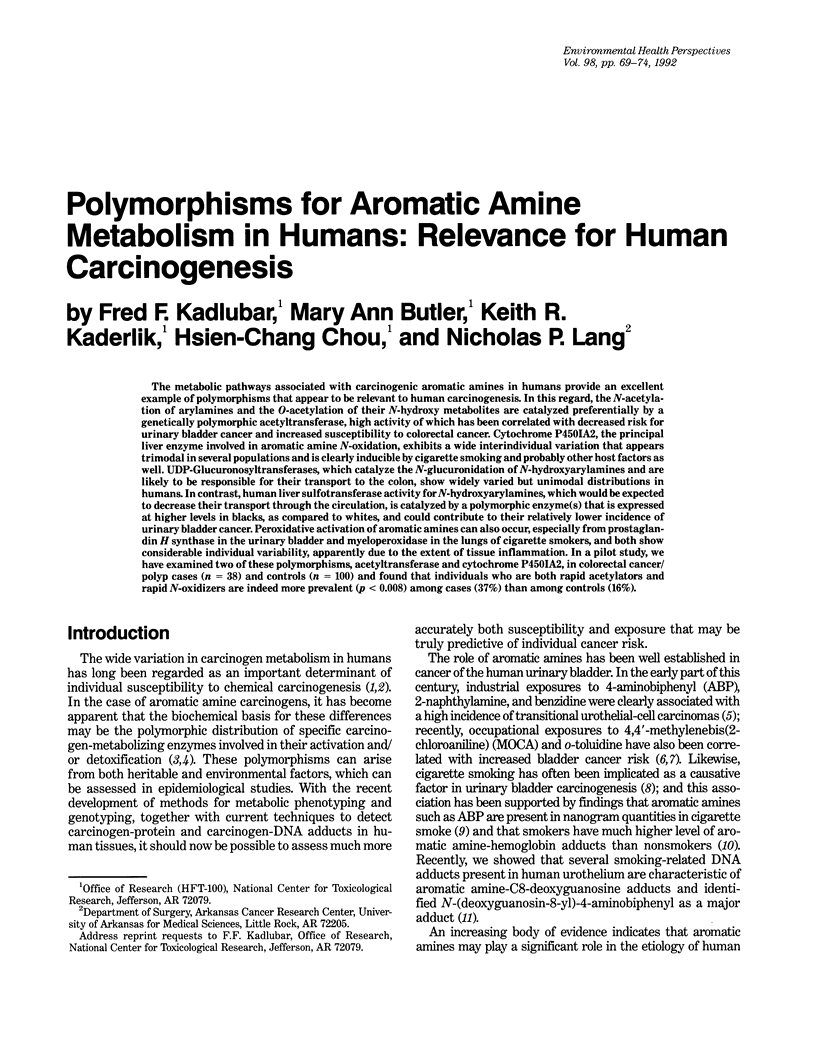
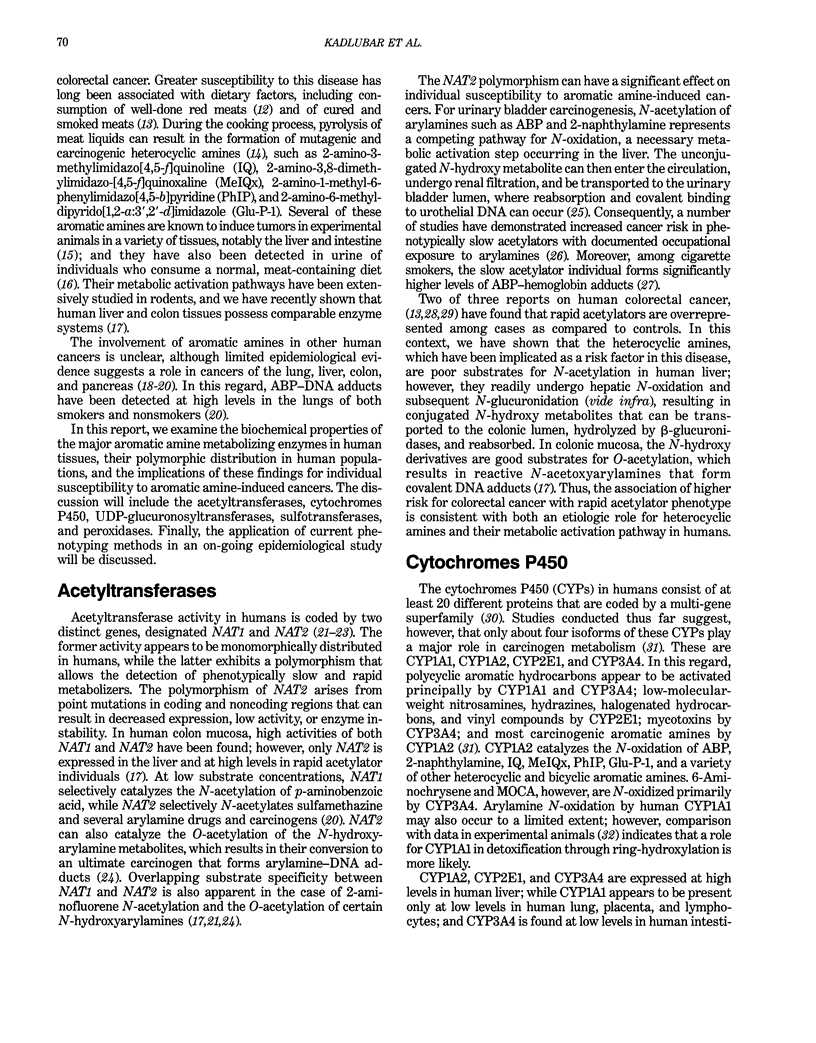
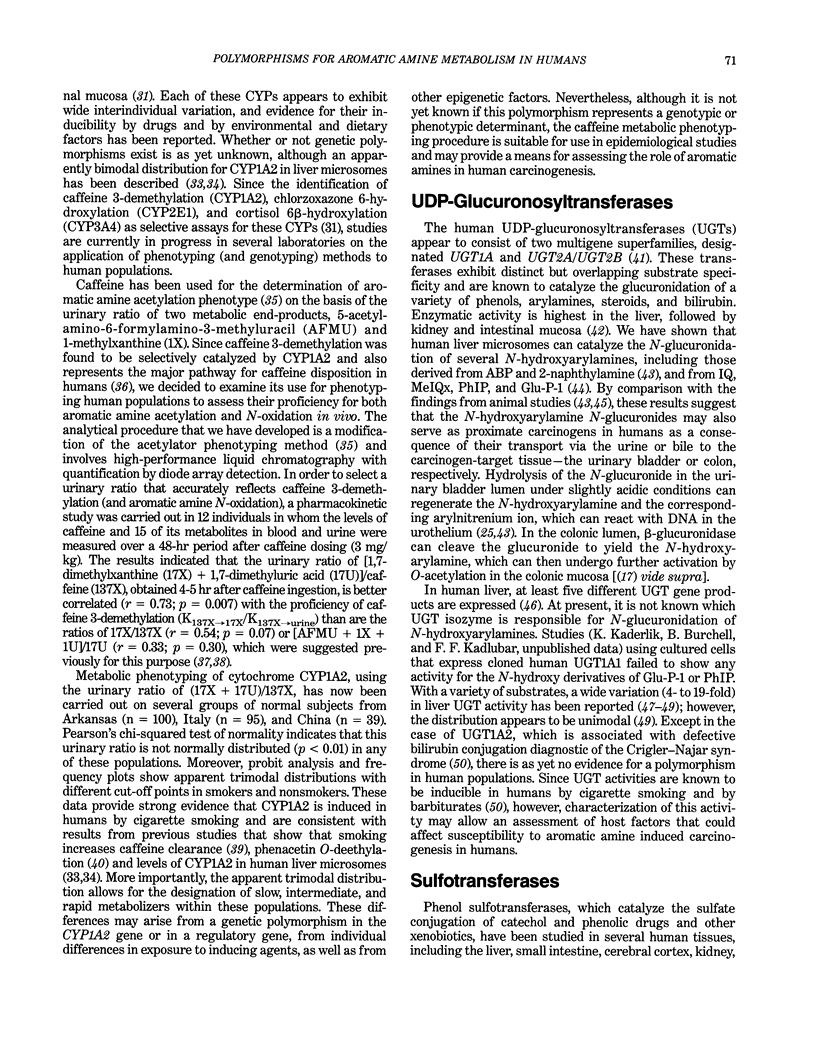
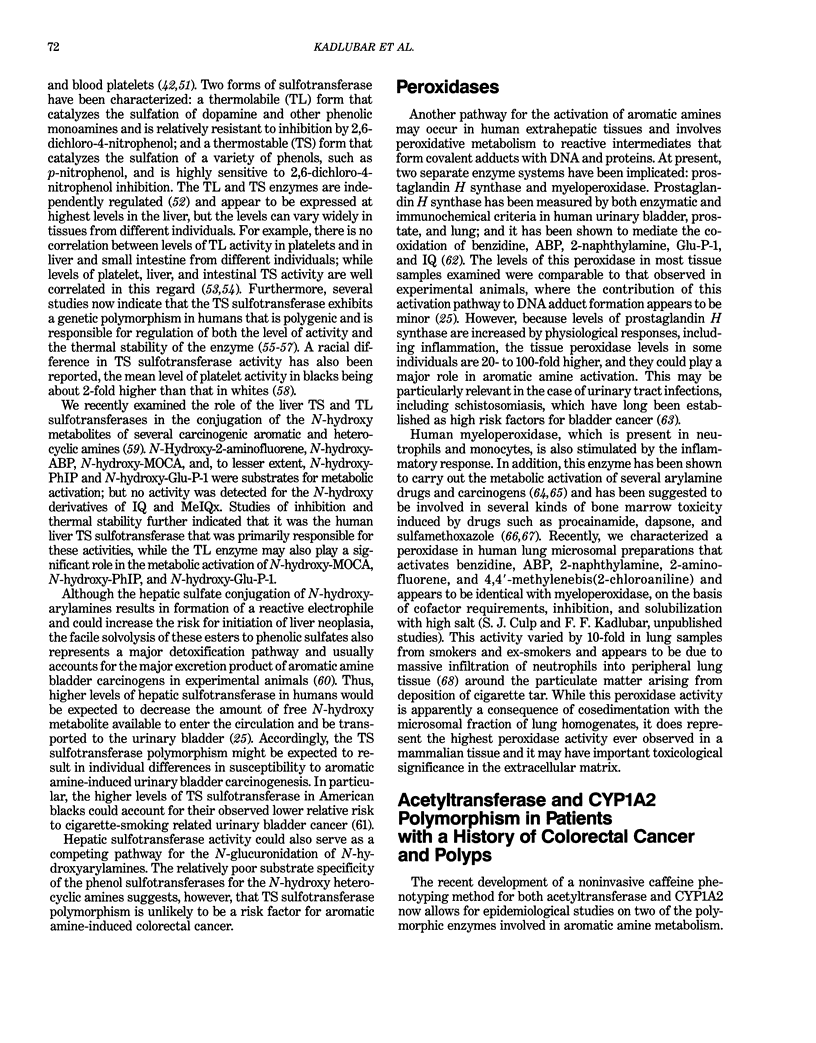
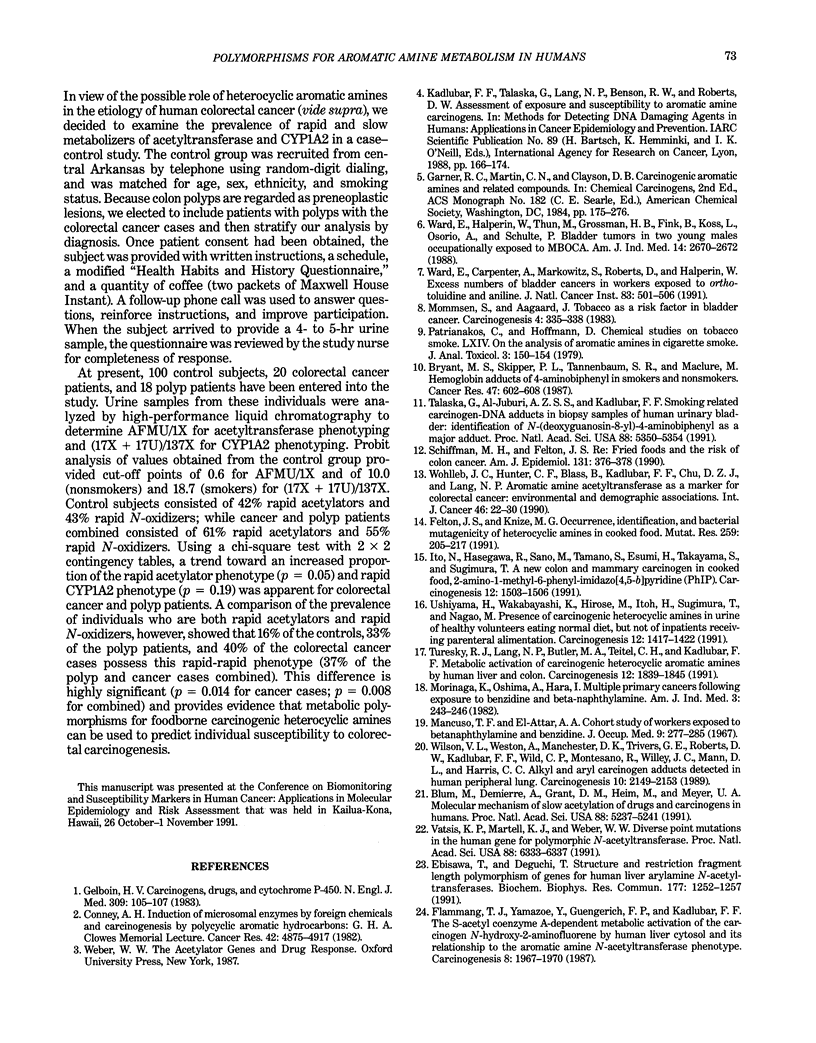
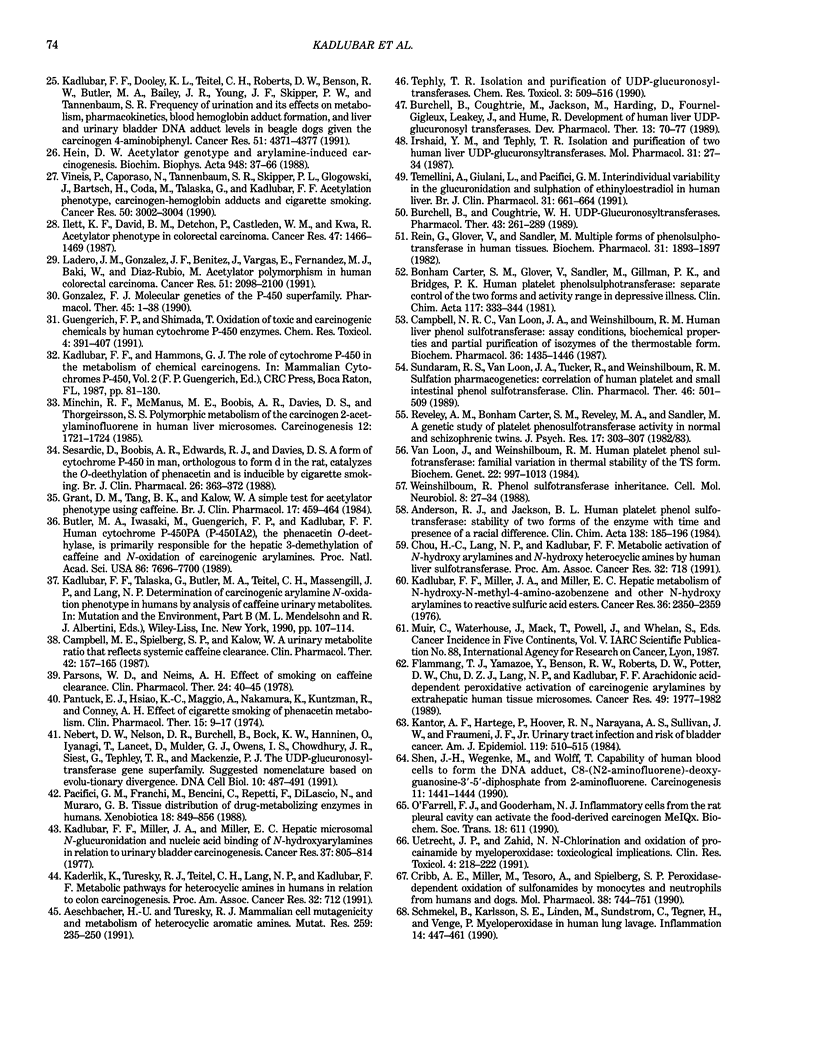
Selected References
These references are in PubMed. This may not be the complete list of references from this article.
- Aeschbacher H. U., Turesky R. J. Mammalian cell mutagenicity and metabolism of heterocyclic aromatic amines. Mutat Res. 1991 Mar-Apr;259(3-4):235–250. doi: 10.1016/0165-1218(91)90120-b. [DOI] [PubMed] [Google Scholar]
- Anderson R. J., Jackson B. L. Human platelet phenol sulfotransferase: stability of two forms of the enzyme with time and presence of a racial difference. Clin Chim Acta. 1984 Apr 13;138(2):185–196. doi: 10.1016/0009-8981(84)90233-x. [DOI] [PubMed] [Google Scholar]
- Blum M., Demierre A., Grant D. M., Heim M., Meyer U. A. Molecular mechanism of slow acetylation of drugs and carcinogens in humans. Proc Natl Acad Sci U S A. 1991 Jun 15;88(12):5237–5241. doi: 10.1073/pnas.88.12.5237. [DOI] [PMC free article] [PubMed] [Google Scholar]
- Bryant M. S., Skipper P. L., Tannenbaum S. R., Maclure M. Hemoglobin adducts of 4-aminobiphenyl in smokers and nonsmokers. Cancer Res. 1987 Jan 15;47(2):602–608. [PubMed] [Google Scholar]
- Burchell B., Coughtrie M. W. UDP-glucuronosyltransferases. Pharmacol Ther. 1989;43(2):261–289. doi: 10.1016/0163-7258(89)90122-8. [DOI] [PubMed] [Google Scholar]
- Burchell B., Coughtrie M., Jackson M., Harding D., Fournel-Gigleux S., Leakey J., Hume R. Development of human liver UDP-glucuronosyltransferases. Dev Pharmacol Ther. 1989;13(2-4):70–77. doi: 10.1159/000457587. [DOI] [PubMed] [Google Scholar]
- Burchell B., Nebert D. W., Nelson D. R., Bock K. W., Iyanagi T., Jansen P. L., Lancet D., Mulder G. J., Chowdhury J. R., Siest G. The UDP glucuronosyltransferase gene superfamily: suggested nomenclature based on evolutionary divergence. DNA Cell Biol. 1991 Sep;10(7):487–494. doi: 10.1089/dna.1991.10.487. [DOI] [PubMed] [Google Scholar]
- Butler M. A., Iwasaki M., Guengerich F. P., Kadlubar F. F. Human cytochrome P-450PA (P-450IA2), the phenacetin O-deethylase, is primarily responsible for the hepatic 3-demethylation of caffeine and N-oxidation of carcinogenic arylamines. Proc Natl Acad Sci U S A. 1989 Oct;86(20):7696–7700. doi: 10.1073/pnas.86.20.7696. [DOI] [PMC free article] [PubMed] [Google Scholar]
- Campbell M. E., Spielberg S. P., Kalow W. A urinary metabolite ratio that reflects systemic caffeine clearance. Clin Pharmacol Ther. 1987 Aug;42(2):157–165. doi: 10.1038/clpt.1987.126. [DOI] [PubMed] [Google Scholar]
- Campbell N. R., Van Loon J. A., Weinshilboum R. M. Human liver phenol sulfotransferase: assay conditions, biochemical properties and partial purification of isozymes of the thermostable form. Biochem Pharmacol. 1987 May 1;36(9):1435–1446. doi: 10.1016/0006-2952(87)90108-0. [DOI] [PubMed] [Google Scholar]
- Carter S. M., Glover V., Sandler M., Gillman P. K., Bridges P. K. Human platelet phenolsulphotransferase: separate control of the two forms and activity range in depressive illness. Clin Chim Acta. 1981 Dec 24;117(3):333–344. doi: 10.1016/0009-8981(81)90121-2. [DOI] [PubMed] [Google Scholar]
- Conney A. H. Induction of microsomal enzymes by foreign chemicals and carcinogenesis by polycyclic aromatic hydrocarbons: G. H. A. Clowes Memorial Lecture. Cancer Res. 1982 Dec;42(12):4875–4917. [PubMed] [Google Scholar]
- Cribb A. E., Miller M., Tesoro A., Spielberg S. P. Peroxidase-dependent oxidation of sulfonamides by monocytes and neutrophils from humans and dogs. Mol Pharmacol. 1990 Nov;38(5):744–751. [PubMed] [Google Scholar]
- Ebisawa T., Deguchi T. Structure and restriction fragment length polymorphism of genes for human liver arylamine N-acetyltransferases. Biochem Biophys Res Commun. 1991 Jun 28;177(3):1252–1257. doi: 10.1016/0006-291x(91)90676-x. [DOI] [PubMed] [Google Scholar]
- Felton J. S., Knize M. G. Occurrence, identification, and bacterial mutagenicity of heterocyclic amines in cooked food. Mutat Res. 1991 Mar-Apr;259(3-4):205–217. doi: 10.1016/0165-1218(91)90118-6. [DOI] [PubMed] [Google Scholar]
- Flammang T. J., Yamazoe Y., Benson R. W., Roberts D. W., Potter D. W., Chu D. Z., Lang N. P., Kadlubar F. F. Arachidonic acid-dependent peroxidative activation of carcinogenic arylamines by extrahepatic human tissue microsomes. Cancer Res. 1989 Apr 15;49(8):1977–1982. [PubMed] [Google Scholar]
- Flammang T. J., Yamazoe Y., Guengerich F. P., Kadlubar F. F. The S-acetyl coenzyme A-dependent metabolic activation of the carcinogen N-hydroxy-2-aminofluorene by human liver cytosol and its relationship to the aromatic amine N-acetyltransferase phenotype. Carcinogenesis. 1987 Dec;8(12):1967–1970. doi: 10.1093/carcin/8.12.1967. [DOI] [PubMed] [Google Scholar]
- Gelboin H. V. Carcinogens, drugs, and cytochromes P-450. N Engl J Med. 1983 Jul 14;309(2):105–107. doi: 10.1056/NEJM198307143090210. [DOI] [PubMed] [Google Scholar]
- Gonzalez F. J. Molecular genetics of the P-450 superfamily. Pharmacol Ther. 1990;45(1):1–38. doi: 10.1016/0163-7258(90)90006-n. [DOI] [PubMed] [Google Scholar]
- Grant D. M., Tang B. K., Kalow W. A simple test for acetylator phenotype using caffeine. Br J Clin Pharmacol. 1984 Apr;17(4):459–464. doi: 10.1111/j.1365-2125.1984.tb02372.x. [DOI] [PMC free article] [PubMed] [Google Scholar]
- Guengerich F. P., Shimada T. Oxidation of toxic and carcinogenic chemicals by human cytochrome P-450 enzymes. Chem Res Toxicol. 1991 Jul-Aug;4(4):391–407. doi: 10.1021/tx00022a001. [DOI] [PubMed] [Google Scholar]
- Hein D. W. Acetylator genotype and arylamine-induced carcinogenesis. Biochim Biophys Acta. 1988 Aug 3;948(1):37–66. doi: 10.1016/0304-419x(88)90004-2. [DOI] [PubMed] [Google Scholar]
- Ilett K. F., David B. M., Detchon P., Castleden W. M., Kwa R. Acetylation phenotype in colorectal carcinoma. Cancer Res. 1987 Mar 1;47(5):1466–1469. [PubMed] [Google Scholar]
- Irshaid Y. M., Tephly T. R. Isolation and purification of two human liver UDP-glucuronosyltransferases. Mol Pharmacol. 1987 Jan;31(1):27–34. [PubMed] [Google Scholar]
- Ito N., Hasegawa R., Sano M., Tamano S., Esumi H., Takayama S., Sugimura T. A new colon and mammary carcinogen in cooked food, 2-amino-1-methyl-6-phenylimidazo[4,5-b]pyridine (PhIP). Carcinogenesis. 1991 Aug;12(8):1503–1506. doi: 10.1093/carcin/12.8.1503. [DOI] [PubMed] [Google Scholar]
- Kadlubar F. F., Dooley K. L., Teitel C. H., Roberts D. W., Benson R. W., Butler M. A., Bailey J. R., Young J. F., Skipper P. W., Tannenbaum S. R. Frequency of urination and its effects on metabolism, pharmacokinetics, blood hemoglobin adduct formation, and liver and urinary bladder DNA adduct levels in beagle dogs given the carcinogen 4-aminobiphenyl. Cancer Res. 1991 Aug 15;51(16):4371–4377. [PubMed] [Google Scholar]
- Kadlubar F. F., Miller J. A., Miller E. C. Hepatic metabolism of N-hydroxy-N-methyl-4-aminoazobenzene and other N-hydroxy arylamines to reactive sulfuric acid esters. Cancer Res. 1976 Jul;36(7 Pt 1):2350–2359. [PubMed] [Google Scholar]
- Kadlubar F. F., Miller J. A., Miller E. C. Hepatic microsomal N-glucuronidation and nucleic acid binding of N-hydroxy arylamines in relation to urinary bladder carcinogenesis. Cancer Res. 1977 Mar;37(3):805–814. [PubMed] [Google Scholar]
- Kadlubar F. F., Talaska G., Butler M. A., Teitel C. H., Massengill J. P., Lang N. P. Determination of carcinogenic arylamine N-oxidation phenotype in humans by analysis of caffeine urinary metabolites. Prog Clin Biol Res. 1990;340B:107–114. [PubMed] [Google Scholar]
- Kantor A. F., Hartge P., Hoover R. N., Narayana A. S., Sullivan J. W., Fraumeni J. F., Jr Urinary tract infection and risk of bladder cancer. Am J Epidemiol. 1984 Apr;119(4):510–515. doi: 10.1093/oxfordjournals.aje.a113768. [DOI] [PubMed] [Google Scholar]
- Ladero J. M., González J. F., Benítez J., Vargas E., Fernández M. J., Baki W., Diaz-Rubio M. Acetylator polymorphism in human colorectal carcinoma. Cancer Res. 1991 Apr 15;51(8):2098–2100. [PubMed] [Google Scholar]
- Mancuso T. F., el-Attar A. A. Cohort study of workers exposed to betanaphthylamine and benzidine. J Occup Med. 1967 Jun;9(6):277–285. [PubMed] [Google Scholar]
- Minchin R. F., McManus M. E., Boobis A. R., Davies D. S., Thorgeirsson S. S. Polymorphic metabolism of the carcinogen 2-acetylaminofluorene in human liver microsomes. Carcinogenesis. 1985 Dec;6(12):1721–1724. doi: 10.1093/carcin/6.12.1721. [DOI] [PubMed] [Google Scholar]
- Mommsen S., Aagaard J. Tobacco as a risk factor in bladder cancer. Carcinogenesis. 1983;4(3):335–338. doi: 10.1093/carcin/4.3.335. [DOI] [PubMed] [Google Scholar]
- Morinaga K., Oshima A., Hara I. Multiple primary cancers following exposure to benzidine and beta-naphthylamine. Am J Ind Med. 1982;3(3):243–246. doi: 10.1002/ajim.4700030303. [DOI] [PubMed] [Google Scholar]
- O'Farrell F. J., Gooderham N. J. Inflammatory cells from the rat pleural cavity can activate the food-derived carcinogen MeIQx. Biochem Soc Trans. 1990 Aug;18(4):611–612. doi: 10.1042/bst0180611. [DOI] [PubMed] [Google Scholar]
- Pacifici G. M., Franchi M., Bencini C., Repetti F., Di Lascio N., Muraro G. B. Tissue distribution of drug-metabolizing enzymes in humans. Xenobiotica. 1988 Jul;18(7):849–856. doi: 10.3109/00498258809041723. [DOI] [PubMed] [Google Scholar]
- Pantuck E. J., Hsiao K. C., Maggio A., Nakamura K., Kuntzman R., Conney A. H. Effect of cigarette smoking on phenacetin metabolism. Clin Pharmacol Ther. 1974 Jan;15(1):9–17. doi: 10.1002/cpt19741519. [DOI] [PubMed] [Google Scholar]
- Parsons W. D., Neims A. H. Effect of smoking on caffeine clearance. Clin Pharmacol Ther. 1978 Jul;24(1):40–45. doi: 10.1002/cpt197824140. [DOI] [PubMed] [Google Scholar]
- Rein G., Glover V., Sandler M. Multiple forms of phenolsulphotransferase in human tissues: selective inhibition by dichloronitrophenol. Biochem Pharmacol. 1982 May 15;31(10):1893–1897. doi: 10.1016/0006-2952(82)90493-2. [DOI] [PubMed] [Google Scholar]
- Reveley A. M., Bonham Carter S. M., Reveley M. A., Sandler M. A genetic study of platelet phenolsulphotransferase activity in normal and schizophrenic twins. J Psychiatr Res. 1982;17(3):303–307. doi: 10.1016/0022-3956(82)90009-7. [DOI] [PubMed] [Google Scholar]
- Schiffman M. H., Felton J. S. Re: "Fried foods and the risk of colon cancer". Am J Epidemiol. 1990 Feb;131(2):376–378. doi: 10.1093/oxfordjournals.aje.a115508. [DOI] [PubMed] [Google Scholar]
- Schmekel B., Hörnblad Y., Linden M., Sundström C., Venge P. Myeloperoxidase in human lung lavage. II. Internalization of myeloperoxidase by alveolar macrophages. Inflammation. 1990 Aug;14(4):455–461. doi: 10.1007/BF00914096. [DOI] [PubMed] [Google Scholar]
- Schmekel B., Karlsson S. E., Linden M., Sundström C., Tegner H., Venge P. Myeloperoxidase in human lung lavage. I. A marker of local neutrophil activity. Inflammation. 1990 Aug;14(4):447–454. doi: 10.1007/BF00914095. [DOI] [PubMed] [Google Scholar]
- Sesardic D., Boobis A. R., Edwards R. J., Davies D. S. A form of cytochrome P450 in man, orthologous to form d in the rat, catalyses the O-deethylation of phenacetin and is inducible by cigarette smoking. Br J Clin Pharmacol. 1988 Oct;26(4):363–372. doi: 10.1111/j.1365-2125.1988.tb03393.x. [DOI] [PMC free article] [PubMed] [Google Scholar]
- Shen J. H., Wegenke M., Wolff T. Capability of human blood cells to form the DNA adduct, C8-(N2-aminofluorenyl)-deoxyguanosine-3'-5'-diphosphate from 2-aminofluorene. Carcinogenesis. 1990 Aug;11(8):1441–1444. doi: 10.1093/carcin/11.8.1441. [DOI] [PubMed] [Google Scholar]
- Sundaram R. S., Van Loon J. A., Tucker R., Weinshilboum R. M. Sulfation pharmacogenetics: correlation of human platelet and small intestinal phenol sulfotransferase. Clin Pharmacol Ther. 1989 Nov;46(5):501–509. doi: 10.1038/clpt.1989.178. [DOI] [PubMed] [Google Scholar]
- Talaska G., al-Juburi A. Z., Kadlubar F. F. Smoking related carcinogen-DNA adducts in biopsy samples of human urinary bladder: identification of N-(deoxyguanosin-8-yl)-4-aminobiphenyl as a major adduct. Proc Natl Acad Sci U S A. 1991 Jun 15;88(12):5350–5354. doi: 10.1073/pnas.88.12.5350. [DOI] [PMC free article] [PubMed] [Google Scholar]
- Temellini A., Giuliani L., Pacifici G. M. Interindividual variability in the glucuronidation and sulphation of ethinyloestradiol in human liver. Br J Clin Pharmacol. 1991 Jun;31(6):661–664. doi: 10.1111/j.1365-2125.1991.tb05589.x. [DOI] [PMC free article] [PubMed] [Google Scholar]
- Tephly T. R. Isolation and purification of UDP-glucuronosyltransferases. Chem Res Toxicol. 1990 Nov-Dec;3(6):509–516. doi: 10.1021/tx00018a004. [DOI] [PubMed] [Google Scholar]
- Turesky R. J., Lang N. P., Butler M. A., Teitel C. H., Kadlubar F. F. Metabolic activation of carcinogenic heterocyclic aromatic amines by human liver and colon. Carcinogenesis. 1991 Oct;12(10):1839–1845. doi: 10.1093/carcin/12.10.1839. [DOI] [PubMed] [Google Scholar]
- Uetrecht J. P., Zahid N. N-Chlorination and oxidation of procainamide by myeloperoxidase: toxicological implications. Chem Res Toxicol. 1991 Mar-Apr;4(2):218–222. doi: 10.1021/tx00020a015. [DOI] [PubMed] [Google Scholar]
- Ushiyama H., Wakabayashi K., Hirose M., Itoh H., Sugimura T., Nagao M. Presence of carcinogenic heterocyclic amines in urine of healthy volunteers eating normal diet, but not of inpatients receiving parenteral alimentation. Carcinogenesis. 1991 Aug;12(8):1417–1422. doi: 10.1093/carcin/12.8.1417. [DOI] [PubMed] [Google Scholar]
- Van Loon J., Weinshilboum R. M. Human platelet phenol sulfotransferase: familial variation in thermal stability of the TS form. Biochem Genet. 1984 Dec;22(11-12):997–1014. doi: 10.1007/BF00499627. [DOI] [PubMed] [Google Scholar]
- Vatsis K. P., Martell K. J., Weber W. W. Diverse point mutations in the human gene for polymorphic N-acetyltransferase. Proc Natl Acad Sci U S A. 1991 Jul 15;88(14):6333–6337. doi: 10.1073/pnas.88.14.6333. [DOI] [PMC free article] [PubMed] [Google Scholar]
- Vineis P., Caporaso N., Tannenbaum S. R., Skipper P. L., Glogowski J., Bartsch H., Coda M., Talaska G., Kadlubar F. Acetylation phenotype, carcinogen-hemoglobin adducts, and cigarette smoking. Cancer Res. 1990 May 15;50(10):3002–3004. [PubMed] [Google Scholar]
- Ward E., Carpenter A., Markowitz S., Roberts D., Halperin W. Excess number of bladder cancers in workers exposed to ortho-toluidine and aniline. J Natl Cancer Inst. 1991 Apr 3;83(7):501–506. doi: 10.1093/jnci/83.7.501. [DOI] [PubMed] [Google Scholar]
- Weinshilboum R. Phenol sulfotransferase inheritance. Cell Mol Neurobiol. 1988 Mar;8(1):27–34. doi: 10.1007/BF00712908. [DOI] [PubMed] [Google Scholar]
- Wilson V. L., Weston A., Manchester D. K., Trivers G. E., Roberts D. W., Kadlubar F. F., Wild C. P., Montesano R., Willey J. C., Mann D. L. Alkyl and aryl carcinogen adducts detected in human peripheral lung. Carcinogenesis. 1989 Nov;10(11):2149–2153. doi: 10.1093/carcin/10.11.2149. [DOI] [PubMed] [Google Scholar]
- Wohlleb J. C., Hunter C. F., Blass B., Kadlubar F. F., Chu D. Z., Lang N. P. Aromatic amine acetyltransferase as a marker for colorectal cancer: environmental and demographic associations. Int J Cancer. 1990 Jul 15;46(1):22–30. doi: 10.1002/ijc.2910460107. [DOI] [PubMed] [Google Scholar]


